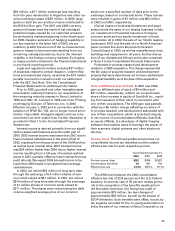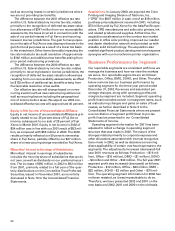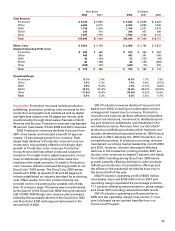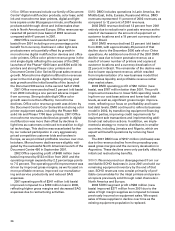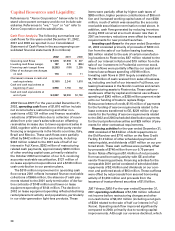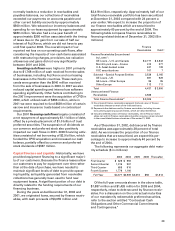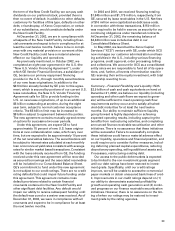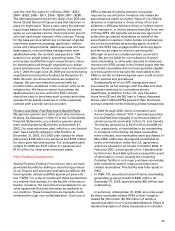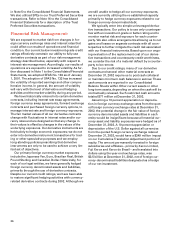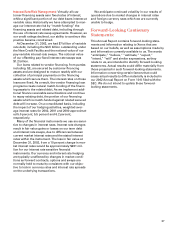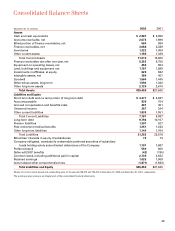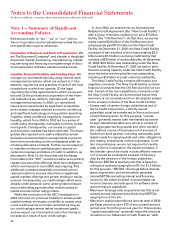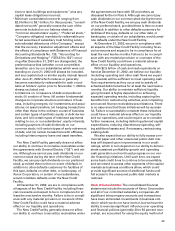Xerox 2002 Annual Report Download - page 35
Download and view the complete annual report
Please find page 35 of the 2002 Xerox annual report below. You can navigate through the pages in the report by either clicking on the pages listed below, or by using the keyword search tool below to find specific information within the annual report.
33
the term of the New Credit Facility, we can pay cash
dividends on our preferred stock, provided there is
then no event of default. In addition to other defaults
customary for facilities of this type, defaults on other
debt, or bankruptcy, of Xerox Corporation, or certain
of our subsidiaries, would constitute defaults under
the New Credit Facility.
At December 31, 2002, we are in compliance with
all aspects of the New Credit Facility including finan-
cial covenants and expect to be in compliance for at
least the next twelve months. Failure to be in compli-
ance with any material provision or covenant of the
New Credit Facility could have a material adverse
effect on our liquidity and operations.
As previously mentioned, in October 2002, we
completed an eight-year agreement in the U.S. (the
“New U.S. Vendor Financing Agreement”), under
which GE Vendor Financial Services, a subsidiary of
GE, became our primary equipment financing
provider in the U.S., through monthly securitizations
of our new lease originations. In addition to the
$2.5 billion already funded by GE prior to this agree-
ment, which is secured by portions of our current U.S.
lease receivables, the New U.S. Vendor Financing
Agreement calls for GE to provide funding in the
U.S. on new lease originations, of up to an additional
$5 billion outstanding at anytime, during the eight
year term, subject to normal customer acceptance
criteria. The $5 billion limit may be increased to
$8 billion subject to agreement between the parties.
The new agreement contains mutually agreed renew-
al options for successive two-year periods.
Under this agreement, we expect GE to fund
approximately 70 percent of new U.S. lease origina-
tions at over-collateralization rates, which vary over
time, but are expected to be approximately 10 percent
of the net receivables balance. The securitizations will
be subject to interest rates calculated at each monthly
loan occurrence at yield rates consistent with average
rates for similar market based transactions. Consistent
with the loans already received from GE, the funding
received under this new agreement will be recorded
as secured borrowings and the associated receivables
will be included in our Consolidated Balance Sheet.
GE’s commitment to fund under this new agreement
is not subject to our credit ratings. There are no credit
rating defaults that could impair future funding under
this agreement. This agreement contains cross
default provisions related to certain financial
covenants contained in the New Credit Facility and
other significant debt facilities. Any default would
impair our ability to receive subsequent funding until
the default was cured or a waiver was received. As of
December 31, 2002, we were in compliance with all
covenants and expect to be in compliance for at least
the next twelve months.
In 2002 and 2001, we received financing totaling
$1,845 million and $1,175 million, respectively, from
GE, secured by lease receivables in the U.S. Net fees
of $16 million were capitalized as debt issue costs.
In connection with these transactions, $150 million
was required to be held in escrow, as security for our
continuing obligations under transferred contracts.
At December 31, 2002, the remaining balance of
$2,323 million was included as debt in our
Consolidated Balance Sheet.
In May 2002, we launched the Xerox Capital
Services (“XCS”) venture with GE, under which XCS
now manages our customer administration and leas-
ing activities in the U.S., including various financing
programs, credit approval, order processing, billing
and collections. We account for XCS as a consolidated
entity since we are responsible to fund all of its opera-
tions, and, further, all events of termination result in
GE receiving their entire equity investment, with total
ownership reverting to us.
Summary – Financial Flexibility and Liquidity: With
$2.9 billion of cash and cash equivalents on hand at
December 31, 2002, we believe our liquidity (including
operating and other cash flows we expect to gener-
ate) will be sufficient to meet operating cash flow
requirements as they occur and to satisfy all sched-
uled debt maturities for at least the next twelve
months. Our ability to maintain sufficient liquidity
going forward is highly dependent on achieving
expected operating results, including capturing the
benefits from restructuring activities, and completing
announced finance receivable securitization and other
initiatives. There is no assurance that these initiatives
will be successful. Failure to successfully complete
these initiatives could have a material adverse effect
on our liquidity, operations and financial position, and
could require us to consider further measures, includ-
ing deferring planned capital expenditures, reducing
discretionary spending, selling additional assets and,
if necessary, restructuring existing debt.
Our access to the public debt markets is expected
to be limited to the non-investment grade segment
until our debt ratings have been restored to invest-
ment grade. Specifically, until our credit ratings
improve, we will be unable to access the commercial
paper markets or obtain unsecured bank lines of cred-
it. Improvements in our credit ratings depend on (1)
our ability to demonstrate sustained profitability
growth and operating cash generation and (2) contin-
ued progress on our finance receivable securitization
initiatives. However, there is no assurance on the tim-
ing of when our ratings may be restored to invest-
ment grade by the rating agencies.


